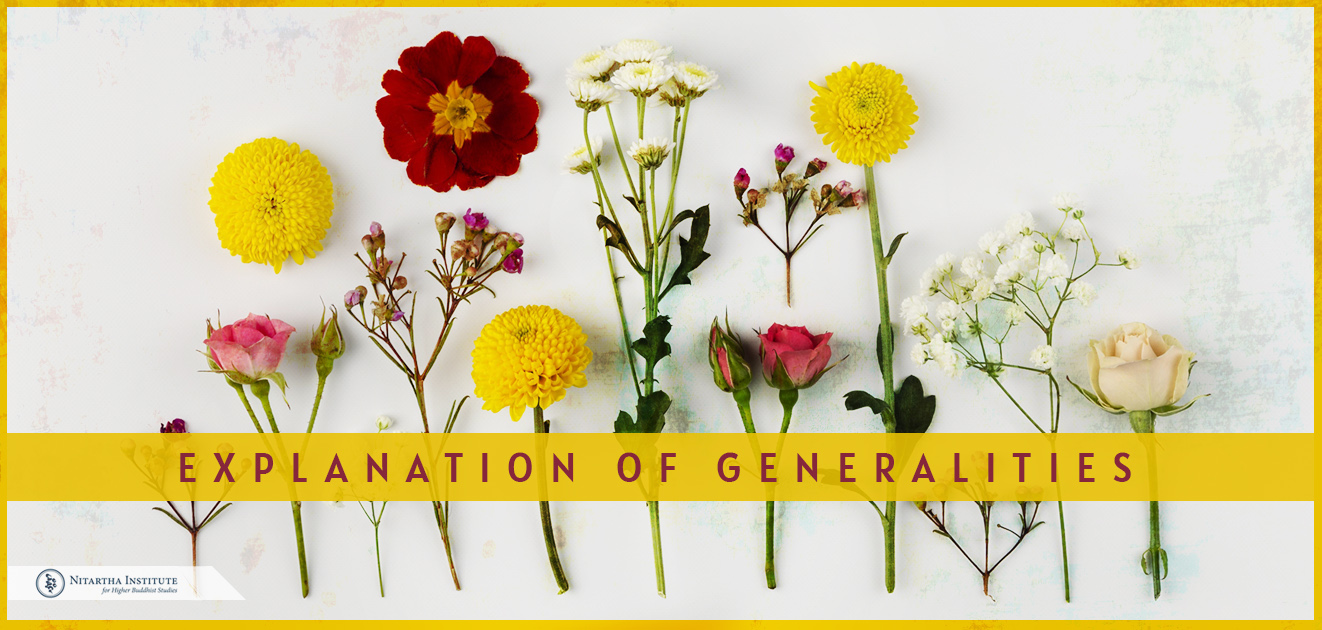This excerpt is copyrighted material, please do not use or copy without written permission from Nitartha Publications.
This course completes the introductory exposition of topics drawn from the Pramāna and Abhidhama traditions, based on the Classifications of Mind and Collected Topics root text. It provides students with the tools for delineating conceptual and non-conceptual mind in meditation, known as the essential modes of engagement of mind. This is followed by the exposition of Buddhist psychology —classification of consciousness into primary minds and mental events.
EXPLANATION OF GENERALITIES
Acharya Lama Tenpa Gyaltsen
Some of the definitions in the Lorik differ from the definitions given in the Collected Topics. But meaning-wise, I think they come out the same. The Lorik is presented from the view explaining what the definitions mean. But when you enter into debate, as we do here in the Collected Topics, the definitions have to be fine-tuned. The words have to be exact because you have to apply them in debate.
You might get a little bit upset when you see, “Oh, now there’s a different definition than in the Lorik.” You might get a little worried, but there is no need for worry. Actually, you should be glad that there are different definitions, it can be a cause for deepening your understanding—for getting a more profound understanding of what the whole thing is about. Then you can really debate the different aspects of the different definitions and find out the best way to say it. You can compare and debate them, and by this, you will refine your understanding. If you just have one definition for the same thing in all the texts, it would get pretty boring, and it would be too easy, and you would not really think about it. You would just learn it by heart and recite it without thinking about it anymore. That gets pretty flat, and you would gain a deeper understanding of what it is talking about. But if you have different definitions, then you have to think about them.
Explanation of generalities
Definition of a generality: that which contains several of its own specific instances.
A basis for definition: Knowable object.
An object of knowledge is a generality. Given a knowable object as the subject, it is a generality, because it has its own specific instances. For the basis of the object of knowledge being a generality, we would posit for its instances all the many divisions of object of knowledge, like things and nothings, permanent phenomenon, and so on.
Student: Do the instances of generality include specifically characterized phenomena?
ALTG: Yes, they are included. But specifically characterized phenomena also have generalities and particulars. For example, pillar is a generality, and it also is a particular.
Translator: If you say “a pillar” or “this pillar,” then it is a specifically characterized phenomenon, but if you just say “pillar,” it is a generality. This problem does not come about in Tibetan, because they do not use articles. It can mean anything.
ALTG: To be precise, in the Tibetan explanation, they say that a generality and a specifically characterized phenomenon are gelwa. They are contradictory phenomena. So a specifically characterized phenomenon is necessarily a particular. Therefore, in the Tibetan tradition, when you say “pillar,” it is something that is not permanent. It is impermanent, and if it is impermanent, then it has to be a thing, and it also has to be a specifically characterized phenomenon. But “pillar” is also a generality because it has many particulars. If we debate this type of pillar that is a generality, we can ask, “Where is it? Whose pillar is it? What kind of function does it perform?” and we will not find something like this.
Student: In debate, when we say, “This pen is impermanent because it is produced,” is “this pen” a specifically characterized phenomenon?
ALTG: In the general mode of explanation, that is what you would say. But in the Tibetan way of debating, if you said “pillar is permanent,” it would be a very strange thing to say. But if you say it is permanent because it is a generally characterized phenomenon, then, through that kind of investigation, it is okay.
Student: Is a generality conditioned or nonconditioned?
ALTG: It is nonconditioned.
Student: Are particulars multiple?
ALTG: Yes, they are multiple.
In general, when we debate and just say “pillar,” we can neither say, “Oh, now, I’m debating in the context of pillar being a generally characterized phenomenon, not specifically characterized,” nor can we say, “Oh, I’m debating about pillar being specifically characterized, not a generally characterized phenomenon.”
Student: How can a generality be nonconditioned if it has multiple particulars?
ALTG: That which has multiple components is not necessarily a conditioned phenomenon. For example, knowable object has a very big inclusion. It has many divisions and particulars, and knowable object is nonconditioned phenomenon because if is not a specifically characterized phenomenon.
Student: In debate, when we say “pot,” is the presumption that you are referring to the specifically characterized phenomenon?
ALTG: In general, when we debate and just say “pillar,” we can neither say, “Oh, now, I’m debating in the context of pillar being a generally characterized phenomenon, not specifically characterized,” nor can we say, “Oh, I’m debating about pillar being specifically characterized, not a generally characterized phenomenon.” In general, when we are debating and we say “pillar,” we are talking about something that can be pulled either way. But when explaining these topics, we characterize them individually.
TERMINOLOGICAL CLASSIFICATION OF GENERALITES
The text says:
The terminological classification of generalities is fourfold: type generality, collection generality, term generality and object generality.
The terminological classifications of generalities have four divisions: type generality, collection generality, term generality, and object generality.
Type Generality
Mind is a type generality because eye consciousness, ear consciousness, nose consciousness, tongue consciousness, and so on come under the category of mind. Thus mind contains several phenomena belonging to its own type. Therefore we should understand that type generality and generality are not gelwa; rather they are tonchik, equivalent.
Collection Generality
Te text says:
- Definition of a collection generality: That which is a collection with several of its own parts.
Bases for definition: A form and a vase.
Collection generality and matter are equivalent.
Here, mind cannot fit into the category of collection generality because, when we really think about mind, it is not something that can be divided into parts. A collection generality has to be something that can be cut up into parts, and aside from matter and form, there are no other things that can be cut up into parts.
Although this is the case, in debate, if we look at the equivalent relationship of collection generality and matter, we would say, “It follows that matter is necessarily a collection generality,” and then you would have to say, “I accept.” But in debate, a fault can occur in our reasoning, especially when we apply it to the Sautrantika and Vaibhashika presentations of subtle and partless particles. We might say, “Given this subtle partless particle as a subject, it follows that it is a collection generality.” But subtle partless particles are partless and directionless, so we have to ask, “Are they or are they not a collection generality?” If we are operating on the basis of this text, we have to say, “Yes, they are a collection generality because matter and collection generality are equivalent.” We have to accept that subtle partless particles are collection generalities? Then they would become something that is multiple and partless. Now, I have made them seem like they are gelwa, but I have not said that they are gelwa, so that we can debate whether partless particles are a collection generality or not.
Student: Are the mental events parts of mind?
ALTG: They are not parts of mind; they are classifications of mind. Right now, we are saying “minds with no parts.”
Student: But the name “mind” exists with multiple mental events.
ALTG: It is true that multiple mental events abide simultaneously with mind, but they are not mutually different parts. They are not a collection of different parts. No matter how many mental events amass together with a primary mnd, they will never become one rough entity. In the example of matter, all the particles of a table come together and form one coarse thing, but that is not the case with mind. In this way, for matter, we say “collection generality.”
Object Generality
The text says:
- Definition of an object generality: A superimposed factor tath is established merely from the perspective of appearances for conceptions.
Definition of the object generality “vase” exists, because it is a superimposed aspect that appears for the conception apprehending “vase” as something similar to a vase and yet is no vase.
Object generality and generally characterized phenomenon are equivalent.
Student: Wouldn’t an object generality be a type of generality? So the relationship between object generality and generality be musum?
ALTG: Gelwa.
Student: But if it is gelwa, how could it be one of the classifications of generalities?
ALTG: These are not the classifications in terms of entity. They are terminological classifications.
Student: Nonetheless, how could something be a classification of something that it has no connection with?
ALTG: The same type of question happened when we looked at the terminological classification of results. The results of separation were not real results, but they were a subdivision of results. Because of this, it fits under the category of terminological classifications. We should remember that a terminological classification means that it does not necessarily have to have a common basis with the basis of divisions or with generality itself. Now, I’ve said the relationship is gelwa between object generality and generality, but this is something you should examine for yourself.
Student: Is the relationship between an object generality and appearing object musum?
ALTG: That is correct. The relationship between object generality and appearing object is musum. What is included in what? Object generality is included in appearing object. Whatever is an object generality is necessarily an appearing object, but whatever is an appearing object is not necessarily an object generality.
Student: Would the appearing object of an eye consciousness not be an object generality?
ALTG: Yes, this directly appearing object is something that is an appearing object but not an object generality.
If we debate the relationship between object generality and generality in a finite and precise way, we will probably arrive at the conclusion that the relationship is gelwa, but if we debate in a general or coarse way, we might arrive at the conclusion that the relationship is musum: An object generality is necessarily a generality, but a generality is not necessarily an object generality, for example, a vase. Vase is a generality, but it is not an object generality.
In debate, you can be very clever in the way we express “vase,” especially in the Tibetan language. When you say “vase,” it does not imply whether it is a specifically characterized phenomenon or a generally characterized phenomenon. When you first say “vase,” you are not saying it either way. You are not classifying either case. In a general debate, you can say “vase,” and you can say that it is not abject generality because it is not a generally characterized phenomenon.
In the same way, we can say that a vase is necessarily not a generally characterized phenomenon and it is necessarily not an object generality because that which is a vase is necessarily a thing and is necessarily impermanent. So people sometimes say that a vase is not a vase because they say it is an isolate of a vase. This style of debate is mostly done by the Gelukpas. In the Gelukpas style of debate, there are many debates that say, “Given the subject, it is not it.” You are not you!
Term Generality
The text says:
- Definition of a term generality: That which includes several means of expression.
One should analyze what is the relationship between type generality and collection generality.





